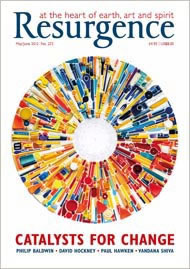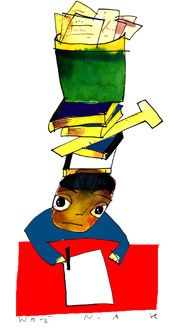When we look at the state of the world today, what is most evident is the fact that the major problems of our time cannot be understood in isolation. They are systemic problems, which means that they are all interconnected and interdependent. One of the most detailed and masterful documentations of the fundamental interconnectedness of world problems is the recent book Plan B by Lester Brown.
Brown, founder of the Worldwatch Institute and, more recently, of the Earth Policy Institute, has been for many years one of the most authoritative environmental thinkers. In this book, he demonstrates with impeccable clarity how the vicious circle of demographic pressure and poverty leads to the depletion of resources – falling water tables, shrinking forests, collapsing fisheries, eroding soils, and so on – and how this resource depletion, exacerbated by climate change, produces failing states whose governments can no longer provide security for their citizens, some of whom in sheer desperation turn to terrorism.
All these problems, ultimately, must be seen as just different facets of one single crisis, which is largely a crisis of perception. It derives from the fact that most people in our society, and especially our large social institutions, subscribe to the concepts of an outdated worldview, a perception of reality inadequate for dealing with our overpopulated, globally interconnected world.
Plan B is Brown’s roadmap for saving civilisation. It is the alternative to ‘business as usual’ (Plan A), which leads to disaster. The main message of the book is that there are solutions to the major problems of our time; some of them even simple. But they require a radical shift in our perceptions, our thinking and our values. And, indeed, we are now at the beginning of such a fundamental change of worldview in science and society; a change of paradigms as radical as the Copernican Revolution.
At the forefront of contemporary science the universe is no longer seen as a machine composed of elementary building blocks. We have discovered that the material world, ultimately, is a network of inseparable patterns of relationships; that the planet as a whole is a living, self-regulating, and self-organising system. The view of the human body as a machine and of the mind as a separate entity is being replaced by one that sees not only the brain, but also the immune system, the bodily tissues, and even each cell as a living, cognitive system. Evolution is no longer seen as a competitive struggle for existence, but rather as a cooperative dance in which creativity and the constant emergence of novelty are the driving forces. And with the new emphasis on complexity, networks, and patterns of organisation, a new science of quality is slowly emerging.
The new conception of life also involves a new kind of thinking – thinking in terms of relationships, patterns and context. In science, this way of thinking is known as ‘systemic thinking’ or ‘systems thinking’. It emerged in the 1920s and 1930s from a series of interdisciplinary dialogues among biologists, psychologists and ecologists. In all these fields, scientists realised that a living system – an organism, ecosystem or social system – is an integrated whole whose properties cannot be reduced to those of smaller parts. The ‘systemic’ properties are properties of the whole, which none of its parts have. So systems thinking involves a shift of perspective from the parts to the whole. The early systems thinkers coined the phrase ‘The whole is more than the sum of its parts’.
When we apply the new conception of life to studying the structures, metabolic processes and evolution of the myriads of species on the planet, we notice immediately that the outstanding characteristic of our biosphere is that it has sustained life for billions of years. How does the Earth do that?
To understand how Nature sustains life, we need to move from biology to ecology, because sustained life is a property of an ecosystem rather than a single organism or species. Over billions of years of evolution, the Earth’s ecosystems have evolved certain principles of organisation to sustain the web of life. Knowledge of these principles of organisation, or principles of ecology, is crucial for designing sustainable human communities.
In the coming decades the survival of humanity will depend on our ecological literacy – our ability to understand the basic principles of ecology and to live accordingly. This means that ecological literacy must become a critical skill for politicians, business leaders and professionals in all spheres, and should be the most important part of education at all levels – from primary and secondary schools to colleges, universities and the continuing education and training of professionals.
At the Center for Ecoliteracy in Berkeley, my colleagues and I have developed a special pedagogy to teach ecological literacy in schools. Our approach is based on the science of ecology, but this is not the only possible approach. Ecoliteracy is also embodied in the traditional knowledge of many Indigenous cultures, and in the school of philosophy known as deep ecology.
This philosophical school was founded by the Norwegian philosopher Arne Naess with the distinction between deep and shallow ecology. Shallow ecology, according to Naess, is anthropocentric. It views humans as above or outside of Nature, as the source of all value, and ascribes only instrumental or use value to Nature. Deep ecology does not separate humans from the natural environment; nor does it separate anything else from it. It does not see the world as a collection of isolated objects but rather as a network of phenomena that are fundamentally interconnected and interdependent. Deep ecology recognises the intrinsic value of all living beings, and views humans as just one particular strand in the web of life.
Ultimately, deep ecological awareness is spiritual awareness. When the concept of the human spirit is understood as the mode of consciousness in which we feel connected to the cosmos as a whole, it becomes clear that ecological awareness is spiritual in its deepest essence.
This article is sourced from a presentation given at the Education for Life conference in Majorca in October 2011. www.pocapoc.org/TAS.html








